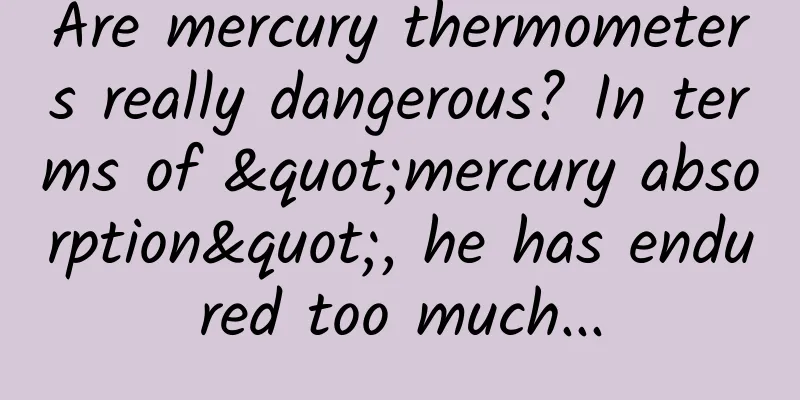Are mercury thermometers really dangerous? In terms of "mercury absorption", he has endured too much...

|
I believe everyone is familiar with mercury thermometers, but as we all know, mercury is a heavy metal with biological toxicity. The Minamata Convention on Mercury also clearly stipulates: "From January 1, 2026, the production of mercury-containing thermometers and mercury-containing sphygmomanometers will be prohibited." So the question is: What harm does mercury cause to organisms? Will the free mercury in nature be absorbed by plants? Tuchong Creative 01 Mercury: a cunning killer Mercury has special physical and chemical properties. At room temperature and pressure, mercury is the only heavy metal that is in liquid form and can exist stably in the atmosphere in the form of a gaseous element for a long time. In nature, mercury is a trace heavy metal element with a very low content, but its biological toxicity is extremely strong. Especially methylmercury, even extremely low levels of methylmercury exposure can cause significant ecological toxicity... The "Minamata disease" incident that occurred in Japan in the 1960s was the most serious mercury poisoning incident in history. Factories discharged a large amount of untreated wastewater containing mercury from industrial production into Minamata Bay. The mercury in the aquatic environment was converted into highly toxic methylmercury, which can be biomagnified 1 million times along the food chain. Residents who ate such mercury-containing seafood for a long time became victims of this methylmercury pollution incident. Tuchong Creative Mercury is a global pollutant that can migrate over long distances with atmospheric circulation. In order to protect humans and the environment from mercury pollution, the Minamata Convention on Mercury officially came into effect on August 16, 2017. Signatory countries must abide by the international mercury convention and reduce the use of mercury-containing products and anthropogenic mercury emissions. The total reservoir of mercury in the global atmosphere is about 5,000 to 5,500 tons, of which the research on the flux of mercury emissions from anthropogenic sources is relatively clear, about 2,000 tons/year, while the process of mercury emissions from natural sources is extremely uncertain, and it is difficult for the current scientific community to accurately estimate its flux. In particular, the exchange of mercury between global forest ecosystems and the atmosphere is estimated to be "-727 to 703 tons/year", which makes it difficult for scientists to determine whether forest ecosystems are the source or sink of atmospheric mercury. Therefore, accurately estimating the source-sink relationship of mercury between forests and the atmosphere is conducive to the rational division of responsibilities in the implementation of the Minamata Convention and provides reasonable support for scientific implementation negotiations. In addition to harming humans, will mercury harm plants? With such questions in mind, the regional biogeochemical cycle research team of mercury, led by Researcher Feng Xinbin from the State Key Laboratory of Environmental Geochemistry, Institute of Geochemistry, Chinese Academy of Sciences, took the subtropical evergreen broad-leaved forest in Ailao Mountain in Yunnan as the research object, and carried out research on the absorption of mercury by vegetation leaves and the biogeochemical cycle of mercury in the roots. They used natural mercury stable isotopes to analyze the source and migration mechanism of mercury in plant leaves and roots, and made important research progress. Most heavy metals can be absorbed from the soil by plant roots, then transferred upward into the above-ground tissues of plants through biological processes such as transpiration, and finally reach the leaves, but the process of mercury absorption by plants is significantly different. Tuchong Creative The surface of plant leaves can absorb gaseous elemental mercury in the atmosphere, and some of the mercury can also enter the interior of the leaves through the photosynthesis/respiration process of the stomata. In addition, the roots of plants can absorb mercury ions from the soil in the form of aqueous solution, but the transmission distance of the absorbed mercury in the root vessels is very limited, so it cannot be transmitted to the aboveground parts. Therefore, the concentration of mercury in plants is usually between a few and tens of ppb (10-9 g/g), which is very low and therefore does not cause toxic effects on plants. However, in special cases, such as in some polluted areas, when the concentration of mercury in plants reaches tens to hundreds of ppm (10-6 g/g), it will significantly affect the physiological processes of plants. Where does the mercury in plants come from and where does it go? The mercury stable isotope composition signature is often referred to as the biogeochemical fingerprint of mercury because it acts like a fingerprint, tracing the source of mercury and the specific reactions in which it participates. We know that atoms are composed of nuclei and extranuclear electrons, where the nuclei are composed of a certain number of protons and neutrons. Isotopes are atoms with the same number of protons but different numbers of neutrons. Mercury has 7 stable isotopes in nature, namely 196Hg, 198Hg, 199Hg, 200Hg, 201Hg, 202Hg, and 204Hg. Mercury shows significantly different mercury isotope characteristics in different end members in nature, which enables us to use mercury isotopes to effectively indicate the source of mercury. For example, the fingerprint characteristics of mercury isotope non-mass fractionation in plant roots inherit the fingerprint characteristics of mercury isotope fractionation in the soil profile, but are obviously different from those in the aboveground parts (trunks, leaves, etc.), which proves that the mercury in plant roots mainly comes from the soil, rather than from the transfer of aboveground tissues. The biomass of vegetation roots is huge, accounting for 22% of the total vegetation. It not only supports the plants, but also plays an important role in the material transport of the plant body. Previously, it was believed that atmospheric mercury absorbed by leaves may be transported downward to the roots of plants. Therefore, the roots of vegetation may be an important sink for atmospheric mercury. Tuchong Creative The latest research from the Institute of Geochemistry of the Chinese Academy of Sciences confirms that the roots of plants absorb mercury ions in the soil solution mainly through the root bark of fine roots. Some mercury can be transferred from the root bark to the root column, which makes the mercury concentration in the root bark about 6 to 10 times that of the root column, and also makes the mercury concentration in the fine roots significantly higher than that in the thick roots. The upward migration process of the mercury absorbed in the roots along the trachea is extremely weak, which makes the mercury concentration in the surface roots significantly higher than that in the bottom layers. In addition, the death of the root system can cause the mercury absorbed by the roots to be released back into the soil, which is a detoxification mechanism for plants and can cause the enrichment of rhizosphere mercury concentration in the soil. Here’s some cool news: Global forests can absorb a large amount of mercury, and the total amount of mercury absorbed each year is approximately equal to the mercury emitted by human activities. However, due to the lack of understanding of the source of mercury in underground roots and the amount of mercury stored, there is a lot of uncertainty in estimating forest mercury sinks. Research by the Institute of Geochemistry, Chinese Academy of Sciences, has confirmed that mercury in plant roots mainly comes from the soil rather than from the transport of aboveground plant parts. This denies the view put forward by previous researchers that roots are a sink for zero-valent atmospheric mercury. Therefore, plant roots should not be included in estimates of the global atmospheric mercury sink. Currently, we are facing the dual pressure of reducing mercury emissions and fulfilling the convention, and are actively implementing the Minamata Convention on Mercury. The formulation of relevant policies for fulfilling the convention and the testing of the effectiveness of emission reduction measures must be based on the scientific understanding of the global mercury biogeochemical cycle. Chinese scientists are making continuous progress on this road to explore the truth. The article is produced by Science Popularization China. Please indicate the source when reprinting. The pictures in this article are from the copyright gallery and are not authorized for reproduction. Editor | Sun Chenyu Author | Yuan Wei, Jia Longyu, Feng Xinbin (Institute of Geochemistry, Chinese Academy of Sciences) Producer | China Science Expo |
>>: How to exercise during COVID-19 recovery? You can do it while lying down
Recommend
Apple releases important iOS 14.8 update: All updates are required to fix security vulnerabilities
Apple today released iOS 14.8, the eighth major u...
Chalcopyrite: Unveil your disguise as gold, you are the hidden boss of the electrification era
This issue introduces a chalcopyrite specimen fro...
The toothbrush in the bathroom is disgusting. Can I put a toothbrush cover on it? The truth is unexpected...
After defecation, flush the toilet. The water and...
National Hypertension Day | You must not know these 5 misunderstandings about lowering blood pressure
Hypertension is the most important risk factor fo...
360 Mini Programs are designed for all scenarios, breaking the boundaries between PC and mobile terminals.
On July 5, 2019, the 360 Mini Program public be...
Why do many people feel pain all over their body after the age of 50? Doctors explain the reason
Many women feel pain all over their body after th...
"Leshan fried skewers are recommended to be banned" has caused controversy! Don't worry, do these 3 things and eat skewers healthily!
Leshan, Sichuan, carries the joy of foodies. If y...
These processes of Apple cannot be copied
[[123145]] "The last thing I want to say abo...
If the theory of evolution is overturned, what other origins do humans have? Will creationism return?
Before the theory of evolution was introduced, th...
Astronauts can turn around by just swinging their arms, but what about satellites without arms?
On December 9, 2021, "space teachers" Z...
How much does it cost to attract investors for the Hegang fast food mini program? What is the investment price for the Hegang fast food mini program?
How much does it cost to attract investment in th...
Baidu Apollo autonomous driving is accelerating its implementation, and smart cars are expanding the in-car entertainment ecosystem
Autonomous driving is getting closer and closer. ...
Concrete operations: basic operation skills and common tools!
I often hear Internet professionals say: "Pro...
If a nuclear bomb were dropped on the Yellowstone volcano, would it cause a huge disaster?
Yellowstone is a supervolcano located in Yellowst...
What is the development prospect of SEO? What can you do after learning SEO?
With the continuous development of the Internet, ...



![Xiaomu C4D Product Rendering 2021 Redshift Course [HD Quality with Materials]](/upload/images/67cc031b1f700.webp)





